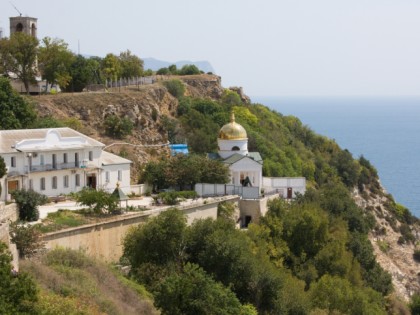Balaklava St. George Monastery
Balaklava St. George Monastery is cut in the rocks of Cape Fiolent by Greek merchants. According to a legend, they miraculously survived on the rocks of the cape during a terrible sea storm. Here they began to offer prayers to George the Victorious, as a result of which Saint George appeared before them. In gratitude for the miracle of salvation in 891 the Greeks founded a Christian cave church right in the rocks. And the rock where St. George appeared was called the rock of the Holy Apparitions.
During the Crimean War of 1853-1856 Balaklava St. George Monastery was used by the Allied forces of England, France and Turkey as a hospital. It was here that one of the first sisters of mercy worked, an Englishwoman Florence Nightingale. By the one-thousandth anniversary of the shrine in the 1890s one of the cave temples was reconstructed and a facade in the classical style was added - thus the Christmas Cathedral appeared. A stone staircase was built from the temple to the sea to the magnificent Jasper beach. Another staircase was also cut down on the rock of the Holy Apparitions which stands alone in the sea and leads to the cross with the face of St. George established here. St. George Monastery was visited by all the Russian emperors beginning with Alexander I. Writers Griboyedov, Pushkin, Bunin, Chekhov, artists Aivazovsky and Vereshchagin also used to visit the monastery. The explorer and connoisseur of the Crimea E. Markov describes the splendor of the local places in the book "Sketches of Crimea": a forest covering mountainous slopes, a sea with scattered lonely cliffs, beaches with colorful pebbles and a breathtaking panorama that opens from the height. In 1929 the monastery was closed, the cross was thrown off the cliff. The cave temple was given to the museum, and the territory of the monastery was given to the recreation house. After the war a military unit was deployed here. Only in 1991 they started the work on the revival of the monastery. St. George Monastery is active since 1993.




































